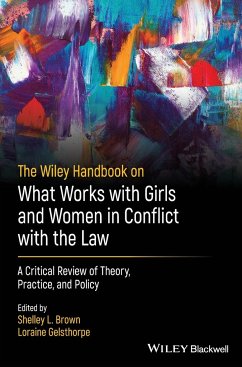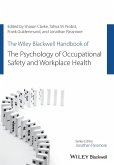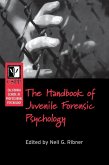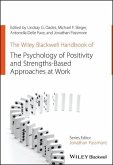The Wiley Handbook on What Works with Girls and Women in Conflict with the Law
A Critical Review of Theory, Practice, and Policy
Herausgeber: Brown, Shelley L; Dixon, Louise; Craig, Leam A; Gelsthorpe, Loraine
The Wiley Handbook on What Works with Girls and Women in Conflict with the Law
A Critical Review of Theory, Practice, and Policy
Herausgeber: Brown, Shelley L; Dixon, Louise; Craig, Leam A; Gelsthorpe, Loraine
- Gebundenes Buch
- Merkliste
- Auf die Merkliste
- Bewerten Bewerten
- Teilen
- Produkt teilen
- Produkterinnerung
- Produkterinnerung
The most practical discussion of the rehabilitation of girls and women in conflict with the law in the correctional arena What Works with Girls and Women in Conflict with the Law is the leading examination of evidence-based practice in the field of gender-responsive corrections. Adopting an international and intersectional approach, the distinguished authors seek to collect the best available data and thinking on what works with girls and women and apply it to the real-world problems facing correctional systems today. As part of its contextual and rich approach to the subject, What Works with…mehr
Andere Kunden interessierten sich auch für
![The Wiley Handbook of Personal Construct Psychology The Wiley Handbook of Personal Construct Psychology]() The Wiley Handbook of Personal Construct Psychology62,99 €
The Wiley Handbook of Personal Construct Psychology62,99 €![The Wiley Blackwell Handbook of the Psychology of Occupational Safety and Workplace Health The Wiley Blackwell Handbook of the Psychology of Occupational Safety and Workplace Health]() Sharon ClarkeThe Wiley Blackwell Handbook of the Psychology of Occupational Safety and Workplace Health59,99 €
Sharon ClarkeThe Wiley Blackwell Handbook of the Psychology of Occupational Safety and Workplace Health59,99 €![The Wiley Blackwell Handbook of the Psychology of Occupational Safety and Workplace Health The Wiley Blackwell Handbook of the Psychology of Occupational Safety and Workplace Health]() Sharon ClarkeThe Wiley Blackwell Handbook of the Psychology of Occupational Safety and Workplace Health196,99 €
Sharon ClarkeThe Wiley Blackwell Handbook of the Psychology of Occupational Safety and Workplace Health196,99 €![The Oxford Handbook of Developmental Psychology and the Law The Oxford Handbook of Developmental Psychology and the Law]() The Oxford Handbook of Developmental Psychology and the Law201,99 €
The Oxford Handbook of Developmental Psychology and the Law201,99 €![Competence in the Law Competence in the Law]() Michael L PerlinCompetence in the Law86,99 €
Michael L PerlinCompetence in the Law86,99 €![The California School of Professional Psychology Handbook of Juvenile Forensic Psychology The California School of Professional Psychology Handbook of Juvenile Forensic Psychology]() NG RibnerThe California School of Professional Psychology Handbook of Juvenile Forensic Psychology101,99 €
NG RibnerThe California School of Professional Psychology Handbook of Juvenile Forensic Psychology101,99 €![The Wiley Blackwell Handbook of the Psychology of Positivity and Strengths-Based Approaches at Work The Wiley Blackwell Handbook of the Psychology of Positivity and Strengths-Based Approaches at Work]() The Wiley Blackwell Handbook of the Psychology of Positivity and Strengths-Based Approaches at Work44,99 €
The Wiley Blackwell Handbook of the Psychology of Positivity and Strengths-Based Approaches at Work44,99 €-
-
-
The most practical discussion of the rehabilitation of girls and women in conflict with the law in the correctional arena What Works with Girls and Women in Conflict with the Law is the leading examination of evidence-based practice in the field of gender-responsive corrections. Adopting an international and intersectional approach, the distinguished authors seek to collect the best available data and thinking on what works with girls and women and apply it to the real-world problems facing correctional systems today. As part of its contextual and rich approach to the subject, What Works with girls and women in conflict with the law, covers a broad variety of topics, ranging from theories of female involvement in crime, security classification and risk assessment, evidence-based treatment and supervision approaches, special populations (such as Indigenous women), to legal/policy developments in the field of gender-responsive corrections. Perfect for students and practitioners in the field of psychology, criminology, social work, criminal justice, and corrections, this is the only reference of its kind to focus on the practical applications of the latest theory.
Produktdetails
- Produktdetails
- Verlag: Wiley
- Seitenzahl: 464
- Erscheinungstermin: 14. März 2022
- Englisch
- Abmessung: 250mm x 175mm x 29mm
- Gewicht: 966g
- ISBN-13: 9781119886419
- ISBN-10: 1119886414
- Artikelnr.: 63046809
- Herstellerkennzeichnung
- Libri GmbH
- Europaallee 1
- 36244 Bad Hersfeld
- gpsr@libri.de
- Verlag: Wiley
- Seitenzahl: 464
- Erscheinungstermin: 14. März 2022
- Englisch
- Abmessung: 250mm x 175mm x 29mm
- Gewicht: 966g
- ISBN-13: 9781119886419
- ISBN-10: 1119886414
- Artikelnr.: 63046809
- Herstellerkennzeichnung
- Libri GmbH
- Europaallee 1
- 36244 Bad Hersfeld
- gpsr@libri.de
Shelley L. Brown, PhD, Department of Psychology, Carleton University, Ottawa, Ontario, Canada. Shelley Brown is an Associate Professor of forensic psychology within the Department of Psychology, Ottawa, Canada. She completed her PhD in 2002 at Queens University with a focus on dynamic risk assessment among adult men under correctional supervision in the community. Following a 10-year research career with Correctional Service of Canada, she joined Carleton University in 2006. Since arriving at Carleton, Shelley's program of research has shifted focus, and now concentrates on improving gender responsive services for girls and women in the criminal justice system using a mix of quantitative and qualitative approaches. In 2006, Shelley co-authored, The assessment and treatment of women offenders: An integrated approach. Since then, she has maintained an active program of research designed to improve the lives of girls and women who come in contact with the criminal justice system. Shelley has also received teaching achievement and mentoring awards since arriving at Carleton. Loraine Gelsthorpe, PhD, Institute of Criminology, University of Cambridge, Cambridge, UK. Loraine Gelsthorpe is Director of the Institute of Criminology and (full) Professor of Criminology and Criminal Justice. She completed her PhD at Cambridge in 1985; she had post-doctoral positions at the University of Lancaster, UCNW (Bangor), and at the LSE, before returning to the Institute as a Senior Research Associate in 1991. She gained a tenured position as a University Lecturer in 1994. Loraine is also Director of the Cambridge ESRC Doctoral Training Partnership (across the Social Sciences in the University), and Director of the Centre for the Study of Global Human Movement, an interdisciplinary initiative across the University. She is a Fellow of the Royal Society of Arts (for distinguished contributions to criminology & criminal justice) and a Fellow of the Academy of Social Sciences (for notable contributions to the social sciences). She was President of the British Society of Criminology 2011-2015, and in 2021 was awarded the European Society of Criminology Lifetime Achievement Award for her outstanding contribution to European Criminology. Her work revolves around women, crime, and criminal justice; human trafficking; criminology, sentencing and the penal system.
Acknowledgements viii
Contributors ix
Introduction 1
Shelley L. Brown and Loraine Gelsthorpe
Part I Theories of Female Offending 11
1 Evolution, Evidence, and Impact of the Feminist Pathways Perspective 13
Kristy Holtfreter, Natasha Pusch, and Katelyn A. Golladay
2 Developmental and Life Course Perspectives on Female Offending 24
Alex R. Piquero, Nicole Leeper Piquero, and Chelsey Narvey
3 Extending Learning, Control, and Strain Perspectives to Explain the
Gender Gap and Female Offending 34
Lisa Broidy and Megan Nyce
4 Understanding Female Crime and Antisocial Behavior through a Biosocial
and Evolutionary Lens 46
Shelley L. Brown and Colleen Robb
Part II Assessment and Security Classification 62
5 Girls and Women in Conflict with the Law: A Review of Risk and Strength
Factors 64
Terri Scott, Megan Wagstaff, and Cassandra Conley
6 Assessment, Security Classification and Humane Prison Environments 77
Kelley Blanchette and Renée Gobeil
7 Advances in Female Risk Assessment 89
Linsey Belisle, Jaclyn Parker Keen, Tereza Trejbalová, Bridget Kelly, and
Emily J. Salisbury
8 Can "Gender Neutral" Risk Assessment Tools be used with Women and Girls?
If so, How? 102
Mark Olver and Keira C. Stockdale
9 Validating Supplementary Needs Assessment Tools for Use with Girls and
Women in Conflict with the Law 120
Jala Rizeq and Tracey Skilling
Part III Exploring the Meaning of Gender Responsive Tenets 135
10 Defining and Evaluating Gender-Responsive Treatment 137
Patricia Van Voorhis
11 Expanding Opportunities for Justice-Involved Women: Transforming the
What and How of Rehabilitation 157
Marilyn Van Dieten
12 Creating a Trauma-Informed Justice System for Women 172
Stephanie Covington
13 Taking Note of Carceral Distance in Family Programs for Incarcerated
Women 185
Caroline Lanskey and Molly Biddle
14 Responding to Problem Substance Use: Deconstructing Structures and
Politicizing the Personal 203
Maria Fotopoulou and Margaret S. Malloch
Part IV Gender Responsive Models in Practice 215
15 Women, Crime, and Justice in Scotland 217
Gill McIvor
16 A Review of Women-Centered Programming and Research Evidence in the
Federal Canadian Context 229
Chantal Allen and Kaitlyn Wardrop
17 Women, Crime and Justice in England and Wales 244
Loraine Gelsthorpe
18 Effective Community Interventions for Justice-Involved Girls and Women
in the United States 256
Merry Morash and Kayla M. Hoskins
19 Evidence-Based Community Supervision Models that Work: The Australian
Approach 267
Rosemary Sheehan
Part V Working with Special Populations Through a Gender Responsive Lens
281
20 Evidence Based Practices with Justice-Involved Indigenous Girls and
Women 283
Leticia Gutierrez and Kayla A. Wanamaker
21 Female Offending During Adolescence and Emerging Adulthood 295
Gilly Sharpe
22 Trauma and Mental Health Among Justice-involved Girls and Women 307
Vivienne de Vogel
23 Personality Disorders and Female Offending 323
Janet I. Warren, Shelly L. Jackson, Elisha R. Agee, Sara B. Millspaugh, and
Maihan F. Alam
24 Female Perpetrators of Sexual Offences 342
Samuel T. Hales and Theresa A. Gannon
25 Female Perpetrators of Intimate Partner Violence 354
Annette McKeown, Patrick J. Kennedy, and Joanne McGrath
Part VI Legal and Policy Implications 369
26 What Works? Beyond Interventions and Programs 371
Loraine Gelsthrope
27 The Impact of Law and Correctional Policies on Women Incarcerated in the
United States 383
Andie Moss and Julie Abbate
28 Successful Resettlement or Setting Women Up to Fail? Policy and Practice
for Women Released from Prison in England and Wales 396
Katy Swaine Williams and Jenny Earle
Conclusion 409
Loraine Gelsthorpe and Shelley L. Brown
Index 415
Contributors ix
Introduction 1
Shelley L. Brown and Loraine Gelsthorpe
Part I Theories of Female Offending 11
1 Evolution, Evidence, and Impact of the Feminist Pathways Perspective 13
Kristy Holtfreter, Natasha Pusch, and Katelyn A. Golladay
2 Developmental and Life Course Perspectives on Female Offending 24
Alex R. Piquero, Nicole Leeper Piquero, and Chelsey Narvey
3 Extending Learning, Control, and Strain Perspectives to Explain the
Gender Gap and Female Offending 34
Lisa Broidy and Megan Nyce
4 Understanding Female Crime and Antisocial Behavior through a Biosocial
and Evolutionary Lens 46
Shelley L. Brown and Colleen Robb
Part II Assessment and Security Classification 62
5 Girls and Women in Conflict with the Law: A Review of Risk and Strength
Factors 64
Terri Scott, Megan Wagstaff, and Cassandra Conley
6 Assessment, Security Classification and Humane Prison Environments 77
Kelley Blanchette and Renée Gobeil
7 Advances in Female Risk Assessment 89
Linsey Belisle, Jaclyn Parker Keen, Tereza Trejbalová, Bridget Kelly, and
Emily J. Salisbury
8 Can "Gender Neutral" Risk Assessment Tools be used with Women and Girls?
If so, How? 102
Mark Olver and Keira C. Stockdale
9 Validating Supplementary Needs Assessment Tools for Use with Girls and
Women in Conflict with the Law 120
Jala Rizeq and Tracey Skilling
Part III Exploring the Meaning of Gender Responsive Tenets 135
10 Defining and Evaluating Gender-Responsive Treatment 137
Patricia Van Voorhis
11 Expanding Opportunities for Justice-Involved Women: Transforming the
What and How of Rehabilitation 157
Marilyn Van Dieten
12 Creating a Trauma-Informed Justice System for Women 172
Stephanie Covington
13 Taking Note of Carceral Distance in Family Programs for Incarcerated
Women 185
Caroline Lanskey and Molly Biddle
14 Responding to Problem Substance Use: Deconstructing Structures and
Politicizing the Personal 203
Maria Fotopoulou and Margaret S. Malloch
Part IV Gender Responsive Models in Practice 215
15 Women, Crime, and Justice in Scotland 217
Gill McIvor
16 A Review of Women-Centered Programming and Research Evidence in the
Federal Canadian Context 229
Chantal Allen and Kaitlyn Wardrop
17 Women, Crime and Justice in England and Wales 244
Loraine Gelsthorpe
18 Effective Community Interventions for Justice-Involved Girls and Women
in the United States 256
Merry Morash and Kayla M. Hoskins
19 Evidence-Based Community Supervision Models that Work: The Australian
Approach 267
Rosemary Sheehan
Part V Working with Special Populations Through a Gender Responsive Lens
281
20 Evidence Based Practices with Justice-Involved Indigenous Girls and
Women 283
Leticia Gutierrez and Kayla A. Wanamaker
21 Female Offending During Adolescence and Emerging Adulthood 295
Gilly Sharpe
22 Trauma and Mental Health Among Justice-involved Girls and Women 307
Vivienne de Vogel
23 Personality Disorders and Female Offending 323
Janet I. Warren, Shelly L. Jackson, Elisha R. Agee, Sara B. Millspaugh, and
Maihan F. Alam
24 Female Perpetrators of Sexual Offences 342
Samuel T. Hales and Theresa A. Gannon
25 Female Perpetrators of Intimate Partner Violence 354
Annette McKeown, Patrick J. Kennedy, and Joanne McGrath
Part VI Legal and Policy Implications 369
26 What Works? Beyond Interventions and Programs 371
Loraine Gelsthrope
27 The Impact of Law and Correctional Policies on Women Incarcerated in the
United States 383
Andie Moss and Julie Abbate
28 Successful Resettlement or Setting Women Up to Fail? Policy and Practice
for Women Released from Prison in England and Wales 396
Katy Swaine Williams and Jenny Earle
Conclusion 409
Loraine Gelsthorpe and Shelley L. Brown
Index 415
Acknowledgements viii
Contributors ix
Introduction 1
Shelley L. Brown and Loraine Gelsthorpe
Part I Theories of Female Offending 11
1 Evolution, Evidence, and Impact of the Feminist Pathways Perspective 13
Kristy Holtfreter, Natasha Pusch, and Katelyn A. Golladay
2 Developmental and Life Course Perspectives on Female Offending 24
Alex R. Piquero, Nicole Leeper Piquero, and Chelsey Narvey
3 Extending Learning, Control, and Strain Perspectives to Explain the
Gender Gap and Female Offending 34
Lisa Broidy and Megan Nyce
4 Understanding Female Crime and Antisocial Behavior through a Biosocial
and Evolutionary Lens 46
Shelley L. Brown and Colleen Robb
Part II Assessment and Security Classification 62
5 Girls and Women in Conflict with the Law: A Review of Risk and Strength
Factors 64
Terri Scott, Megan Wagstaff, and Cassandra Conley
6 Assessment, Security Classification and Humane Prison Environments 77
Kelley Blanchette and Renée Gobeil
7 Advances in Female Risk Assessment 89
Linsey Belisle, Jaclyn Parker Keen, Tereza Trejbalová, Bridget Kelly, and
Emily J. Salisbury
8 Can "Gender Neutral" Risk Assessment Tools be used with Women and Girls?
If so, How? 102
Mark Olver and Keira C. Stockdale
9 Validating Supplementary Needs Assessment Tools for Use with Girls and
Women in Conflict with the Law 120
Jala Rizeq and Tracey Skilling
Part III Exploring the Meaning of Gender Responsive Tenets 135
10 Defining and Evaluating Gender-Responsive Treatment 137
Patricia Van Voorhis
11 Expanding Opportunities for Justice-Involved Women: Transforming the
What and How of Rehabilitation 157
Marilyn Van Dieten
12 Creating a Trauma-Informed Justice System for Women 172
Stephanie Covington
13 Taking Note of Carceral Distance in Family Programs for Incarcerated
Women 185
Caroline Lanskey and Molly Biddle
14 Responding to Problem Substance Use: Deconstructing Structures and
Politicizing the Personal 203
Maria Fotopoulou and Margaret S. Malloch
Part IV Gender Responsive Models in Practice 215
15 Women, Crime, and Justice in Scotland 217
Gill McIvor
16 A Review of Women-Centered Programming and Research Evidence in the
Federal Canadian Context 229
Chantal Allen and Kaitlyn Wardrop
17 Women, Crime and Justice in England and Wales 244
Loraine Gelsthorpe
18 Effective Community Interventions for Justice-Involved Girls and Women
in the United States 256
Merry Morash and Kayla M. Hoskins
19 Evidence-Based Community Supervision Models that Work: The Australian
Approach 267
Rosemary Sheehan
Part V Working with Special Populations Through a Gender Responsive Lens
281
20 Evidence Based Practices with Justice-Involved Indigenous Girls and
Women 283
Leticia Gutierrez and Kayla A. Wanamaker
21 Female Offending During Adolescence and Emerging Adulthood 295
Gilly Sharpe
22 Trauma and Mental Health Among Justice-involved Girls and Women 307
Vivienne de Vogel
23 Personality Disorders and Female Offending 323
Janet I. Warren, Shelly L. Jackson, Elisha R. Agee, Sara B. Millspaugh, and
Maihan F. Alam
24 Female Perpetrators of Sexual Offences 342
Samuel T. Hales and Theresa A. Gannon
25 Female Perpetrators of Intimate Partner Violence 354
Annette McKeown, Patrick J. Kennedy, and Joanne McGrath
Part VI Legal and Policy Implications 369
26 What Works? Beyond Interventions and Programs 371
Loraine Gelsthrope
27 The Impact of Law and Correctional Policies on Women Incarcerated in the
United States 383
Andie Moss and Julie Abbate
28 Successful Resettlement or Setting Women Up to Fail? Policy and Practice
for Women Released from Prison in England and Wales 396
Katy Swaine Williams and Jenny Earle
Conclusion 409
Loraine Gelsthorpe and Shelley L. Brown
Index 415
Contributors ix
Introduction 1
Shelley L. Brown and Loraine Gelsthorpe
Part I Theories of Female Offending 11
1 Evolution, Evidence, and Impact of the Feminist Pathways Perspective 13
Kristy Holtfreter, Natasha Pusch, and Katelyn A. Golladay
2 Developmental and Life Course Perspectives on Female Offending 24
Alex R. Piquero, Nicole Leeper Piquero, and Chelsey Narvey
3 Extending Learning, Control, and Strain Perspectives to Explain the
Gender Gap and Female Offending 34
Lisa Broidy and Megan Nyce
4 Understanding Female Crime and Antisocial Behavior through a Biosocial
and Evolutionary Lens 46
Shelley L. Brown and Colleen Robb
Part II Assessment and Security Classification 62
5 Girls and Women in Conflict with the Law: A Review of Risk and Strength
Factors 64
Terri Scott, Megan Wagstaff, and Cassandra Conley
6 Assessment, Security Classification and Humane Prison Environments 77
Kelley Blanchette and Renée Gobeil
7 Advances in Female Risk Assessment 89
Linsey Belisle, Jaclyn Parker Keen, Tereza Trejbalová, Bridget Kelly, and
Emily J. Salisbury
8 Can "Gender Neutral" Risk Assessment Tools be used with Women and Girls?
If so, How? 102
Mark Olver and Keira C. Stockdale
9 Validating Supplementary Needs Assessment Tools for Use with Girls and
Women in Conflict with the Law 120
Jala Rizeq and Tracey Skilling
Part III Exploring the Meaning of Gender Responsive Tenets 135
10 Defining and Evaluating Gender-Responsive Treatment 137
Patricia Van Voorhis
11 Expanding Opportunities for Justice-Involved Women: Transforming the
What and How of Rehabilitation 157
Marilyn Van Dieten
12 Creating a Trauma-Informed Justice System for Women 172
Stephanie Covington
13 Taking Note of Carceral Distance in Family Programs for Incarcerated
Women 185
Caroline Lanskey and Molly Biddle
14 Responding to Problem Substance Use: Deconstructing Structures and
Politicizing the Personal 203
Maria Fotopoulou and Margaret S. Malloch
Part IV Gender Responsive Models in Practice 215
15 Women, Crime, and Justice in Scotland 217
Gill McIvor
16 A Review of Women-Centered Programming and Research Evidence in the
Federal Canadian Context 229
Chantal Allen and Kaitlyn Wardrop
17 Women, Crime and Justice in England and Wales 244
Loraine Gelsthorpe
18 Effective Community Interventions for Justice-Involved Girls and Women
in the United States 256
Merry Morash and Kayla M. Hoskins
19 Evidence-Based Community Supervision Models that Work: The Australian
Approach 267
Rosemary Sheehan
Part V Working with Special Populations Through a Gender Responsive Lens
281
20 Evidence Based Practices with Justice-Involved Indigenous Girls and
Women 283
Leticia Gutierrez and Kayla A. Wanamaker
21 Female Offending During Adolescence and Emerging Adulthood 295
Gilly Sharpe
22 Trauma and Mental Health Among Justice-involved Girls and Women 307
Vivienne de Vogel
23 Personality Disorders and Female Offending 323
Janet I. Warren, Shelly L. Jackson, Elisha R. Agee, Sara B. Millspaugh, and
Maihan F. Alam
24 Female Perpetrators of Sexual Offences 342
Samuel T. Hales and Theresa A. Gannon
25 Female Perpetrators of Intimate Partner Violence 354
Annette McKeown, Patrick J. Kennedy, and Joanne McGrath
Part VI Legal and Policy Implications 369
26 What Works? Beyond Interventions and Programs 371
Loraine Gelsthrope
27 The Impact of Law and Correctional Policies on Women Incarcerated in the
United States 383
Andie Moss and Julie Abbate
28 Successful Resettlement or Setting Women Up to Fail? Policy and Practice
for Women Released from Prison in England and Wales 396
Katy Swaine Williams and Jenny Earle
Conclusion 409
Loraine Gelsthorpe and Shelley L. Brown
Index 415








